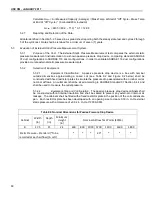
USE OM - JANUARY 2017
60
Calculate m
c
pm
= Air Measured Capacity (Average) / (Mass Temp at Start of
“Off” Cycle – Mass Temp
at End of
“Off” Cycle) * (6 minutes/60 minutes/Hr)
mc
pm
= 2435 / (89.9
– 71.0) * 0.1 = 12.88
5.2.7
Reporting and Retention of the Data.
All data identified in Section 5.2.5 saved in a spread sheet reporting both the steady state test and cycles 2 through
5 of the cyclic test. Data shall be retained for a minimum of seven (7) years.
5.3
Evaluation of External Static Pressure Measurement System
.
5.3.1
Purpose of the Test
. The External Static Pressure Measurement test compares the external static
pressure measurement instrumentation to a known passive pressure drop device, comparing standard ASHRAE
37 duct configurations to ASHRAE 116 duct configurations, in order to validate ASHRAE 116 duct configurations
provide accurate external static pressure measurements.
5.3.2
Selection of Equipment
.
5.3.2.1
Equipment Classification.
A passive pressure drop device is a box with nominal
outside dimensions approximating a cased coil (see Table K2 and Figure K2 below) shall be
constructed with fixed restrictor plates to simulate the pressure drop associated with an indoor coil at
nominal airflows. An outlet duct shall be sized according to ASHRAE Standard 37 Section 6.4.4 and
shall be used to measure the outlet pressure.
5.3.2.2
Equipment Size and Configuration
. The passive pressure drop device cabinets shall
be constructed without internal insulation and shall be sealed to prevent any external or internal air
leakage. The cabinets shall be fitted with a fixed restrictor plate in the position of the coil condensate
pan. Each restrictor plate has been developed with an opening size to create 0.30 in. H
2
O external
static pressure with a tolerance of ±0.02 in. H
2
O at 1200 SCFM.
Table K2. Nominal Dimensions for Passive Pressure Drop Device
Cabinet
Width
(in)
Depth
(in)
Minimum
Height
(in)
Nominal Airflow Test Points (SCFM)
B
17.5
21
24
600
800 1000 1200
1400
1600
1800
Static Pressure – Standard (*To be
recorded at each airflow) (in H
2
O)
*
*
*
.30”
*
*
*





























